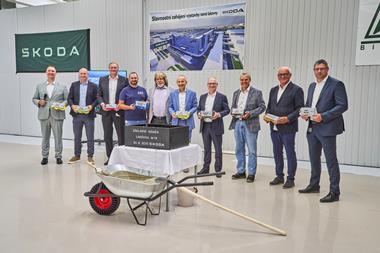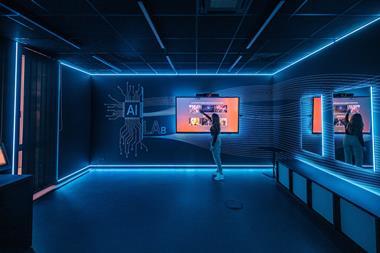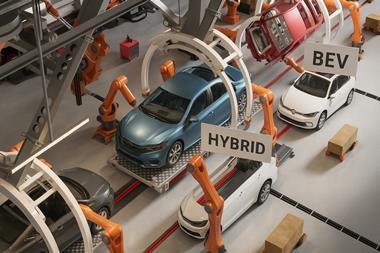Ferrari is renowned for the high quality paint finish on its supercars. So creating a workable paint formulation that would cure at much lower temperatures without compromising these exacting standard would be a challenge. PPG’s Technical director, William Brunat, discusses the project with Nick Holt
 The project with Ferrari was really interesting. Would you be able to give me an overview of it? Did you approach Ferrari or did they approach you?
The project with Ferrari was really interesting. Would you be able to give me an overview of it? Did you approach Ferrari or did they approach you?
They approached us and we were more than happy to move in this direction. It started in early 2017 when they decided to move towards the low-cure process. It provides lots of benefits, including energy savings, the ability to coat low-temperature substrate like CFRPs, etc. And for us, we have always seen that as the next big trend in the industry. So it was a perfect fit together with Ferrari.
That’s easily said but much more difficult to do. Firstly, because their specifications are pretty stringent, which means that it was not easy to move from conventional temperature, which is 140˚C, down to 90˚C. I mean a 50˚C reduction in temperature is quite a lot. So, we had to completely review the formulation of the coatings and introduce new technologies. As they were, none of the colours, none of the basecoats and, of course, not the clearcoat, were able to pass Ferrari’s specifications when cured at 90˚C.
They were using conventional waterborne basecoats and conventional 1K clearcoat. One of the issues is that the 1K clearcoat does not cure at all at 90˚C, so we had to move towards the 2K clearcoat. But not a conventional 2K clearcoat because the specifications were not allowing for using an already formulated technology. So we had to use new resins and also a new hardener to be compliant with their specifications.
The same for the waterborne basecoats. We had to use new resins and a new cross-linking mechanism to be able to cure properly at 90˚C and get the properties [required]. Especially difficult were the windshield adhesion and, of course, the humidity resistance. When you immerse the panels, you have to have no defect for a certain time and also adhesion, and we have seen issues here. So, it has really been the development of new technologies.
One thing I’d like to mention is the number of colours that Ferrari use. It’s at least 70 colours and when you compare that to a conventional paintshop, where you have perhaps 15 colours, you see the amount of work. The approval matrix has been huge and we had only 18 months to do that.
So the whole project was 18 months from start to finish?
Yes. It started early 2017 and the SOP was mid-April. You know, at Ferrari, failure is not an option, of course. For any customer it is not an option, but even less at Ferrari. And when you have 70 colours and you reduce the curing temperature and all the colours have to be okay, you’d better have good planning and a good partnership with the customer, and that has been the case. We have an excellent partnership with Ferrari. We’ve conducted numerous trials at nights, during the weekends, all the steps have been validated by Ferrari, so it was really a combined effort to make sure that we were in time, being able to fulfil their requirements.
Appearance, of course, was of extremely high importance, as well as workability, because there was no doubt that the technology could not slow down the pace of the paintshop. At Ferrari they are not making 1,000 cars a day but the cars they make have to be of the same high quality, so this new technology must not reduce the application workability, or the ability to produce new colours.
So, it had to be compliant with not only the glossy clearcoat, but with the matte clearcoat and with any effect we would have been able to achieve with the previous technology.
It’s now been more than four months, almost five months since we launched, and we can say no doubt it’s a success.
You mentioned the number of colours there. Did you find there were differences when you initially started the project and that some colours would cure better than others? Was that down to pigments and metallics and levels of those within the paint and the clearcoat?
Exactly. At the beginning we were hoping that maybe we could reformulate the current technology, but as you mentioned, depending on the colours, some of them were more critical, especially the ones with a high level of pigments. In the end, we had to change the overall technology. So, we’ve used new resins, a new cross-linking mechanism, and that allowed us to be able to fulfil the requirement for all colours but also to make sure that in the future we would be able to use that technology for any colours they might want. And you know that Ferrari put a lot of attention and focus on a few colours, especially the reds, and small changes had to be within their specification.
Did you start out with some existing formulations or was it almost a scratch start with the formulation for the whole project?
Let me say we have been working on low-cure for a while so the request from Ferrari was a good fit. We used that knowledge and that experience we had in developing low-cure resins – not yet industrial, but low-cure resins – to be used industrially.
Now you have developed this new low-temperature formulation that can be used across multiple pigment formulations that meet Ferrari’s exacting criteria, could it be scaled for higher volume manufacturers?
Absolutely. It’s my best wish that we build on this experience and the success of the project. I know there’s interest in the industry regarding low-cure, and although there are some low-cure paints already [in the market] they are not at that level, that intensity in terms of jobs per day. Don’t misunderstand me, Ferrari’s production levels are not the 2,000 cars per day that a PSA or Renault plant can produce, but this is a significant step, certainly, and we want to build on that.
Are there any changes in the process time with the low-cure paint system?
No, it was the same. No different.
In terms of application systems and the curing booth and things like that, were there any changes required there at all?In the oven, no. Now, in application, they had to change their atomisers because they had to go from 1K to 2K, so they had to adjust their application equipment to add the hardener and also the mixer. For the rest, let’s put it this way, if you would take a plant running today water-borne basecoats and 2K clearcoat, there would be no change.
Going back to your comment about the number of different pigments and colour variations you were dealing with, was it a big challenge to get the consistency in terms of the appearance and the cured appearance? Also, in terms of the durability and things like UV resistance?
In terms of durability, no, because we are using pigments which are all fully tested in terms of durability. But we have not seen any issue here and we were not expecting any.
One issue was appearance. Some of the colours, because of their intrinsic formulation, containing high loads of mica and aluminium, were showing worse appearance than others. And that has been kind of a headache to us for some of the colours. But it has also allowed us to learn a lot from that technology. And with the experience we have now, and the right range of colours that we are supplying to Ferrari, we are in very good shape to design any colour that may be of interest to our customers in the future.
You mentioned that the low temperature allows or makes it easier to apply onto multi-material substrates, so I assume you’re looking at applications on carbon composites, aluminium, possibly magnesium, with companies like Ferrari.It would be more plastics because for aluminium we can use conventional paint systems. It’s more for low TG/TM plastics and also CFRPs.
Do you know what the average energy savings were per vehicle at Ferrari?
I don’t know, as this is proprietary information from Ferrari. But you can drastically simplify your supply chain because you can use the same batches of paint both on the bodies and on the plastics, etc. so the colour match would be perfect. All types of complexity in supply chain, outsourcing, etc., could be reduced.
You were talking about how the trend in paint application or paint coating for automotive is low-cure. You’ve currently got it down to about 100˚C. Do you see temperatures going any lower than they are at the moment?
I don’t think so. At least, in the next ten years I don’t see that. You know, the properties are somewhat related with the chemistries that you are using, and the chemistry depends on the cure temperature. There are some room-temperature chemistries but those are not fit for the requirements and the application processes of a [car] body today. The industry is looking towards being able to coat everything inline, and again benefit from reduced supply chain and improved colour harmony. Plus the energy savings and being able to coat everything at once. But I think 90˚C plus or minus 10˚C is the target.
What do you see are the biggest challenges or opportunities in terms of automotive coating looking forward in the next five to ten years?
I would say I see two major challenges. The first one is that in order to get some differentiation, more and more models are going to be introduced in the next few years, and the arrival of EVs, shared, autonomous, connected, whatever you want to call that, is also going to impact that on the one side. And on the other side, the paintshops and the automakers have a huge pressure to reduce costs. Of course, that cannot be made by sacrificing performance, and we need to make sure that the workability is not compromised.
Having said that, we need to have more planning proactivity within our teams to make sure that we can deliver on reduced duration for developments, smoother launches, and cheaper costs to coat their bodies in the end. Which means also that without having excellent relationships and partnerships with our customers it’s a dead end. With strong working relationships it’s a win/win, or it will be for the loss of both sides – because of, again, the pressure of having more models, more colours, shorter duration, lower costs and increased complexity in the end.
That would be my first challenge. Another one would be regulation. I’m sure you’ve heard about REACH. As a human being, this is excellent. But as a paint formulator it is somewhat problematic in the choice of the chemicals that we are using, and are going to use.
As you know, regulation can change very quickly, very abruptly and no one wants to start a development – you know it takes anything between one to five years for a technology to be implemented into the automotive industry – and when it comes to the launch, suddenly you cannot use the chemical.
So we have to be extremely aware of any change, any early signal, anything that could potentially change the regulation, the classification, and making sure that we are prepared because our customers are global – globally, we are watching that and making sure we react appropriately.
You spoke about mobility and EVs. That’s certainly a challenge and an opportunity. 20 years ago everybody was saying, you know what, in 2010 90% of the bodies will be fully aluminium. Guess what. It did not happen. I think with e-mobility, hopefully, we are better in our predictions, but for sure it’s going to change. And we think change is coming here in the coatings industry.
I don’t know if you’re aware but we have created a mobility team where we are looking at what changes might form developments in mobility, new vehicles and technologies. We are [already] working on solutions, such as coatings that are more easily detected by lidar [systems]. Also, easy-to-clean coatings for lenses on cameras or sensors, to improve the safety on the roads by having better detection capability in hard climates.









































